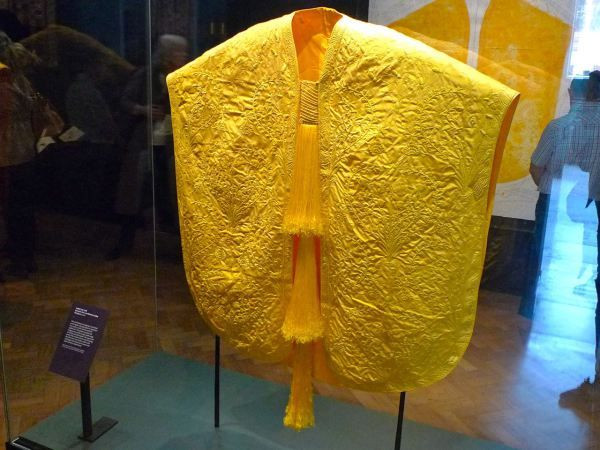The world's rarest silk weaves from the silk of millions of spiders
The shiny gold silk woven from the silk of a million spiders on Madagascar is a unique masterpiece in the world.
The world's largest and rarest silk cloth produced entirely from silk of the golden globe weaver spider displayed at the American Museum of Natural History in New York in 2009, according to Ancient Origins. This is said to be the only large fabric woven from natural spider silk that exists in the world today.
Artisans weave and embroider silk silk scarves.(Video: Vimeo).
This masterpiece cloth is a project of Simon Peers, an English art historian specializing in fabric and Nicholas Godley , an American businessman. The project takes 5 years to complete with a cost of US $ 395,820. The result from the project is a cloth measuring 3.4 x 1.2 meters.
The product of Peers and Godley is a yellow brocade shawl . The inspiration for the cloth came from a 19th-century French record. The record depicts the attempt of French missionary pastor Paul Camboué to exploit and produce fabrics from spider silk. Father Camboué is seen as the first person to succeed in this area. However, spider silk has been harvested in ancient times for many different purposes. For example, the ancient Greeks used spider silk to stop bleeding in wounds.

Silk silk shawl displayed in the museum.(Photo: Blogspot).
When missionary in Madagascar, Father Camboué took advantage of a species of spider available on the island to produce spider silk. He collaborated with a merchant named M. Nogué to open the spider silk fabric. Their products attracted a lot of attention at the time and inspired Inspiration to help Peers and Gogley rebuild their silk mining technology after a century.
Peers rebuilt a copy of the silk mining machine invented by Nogué. The small machine is manually controlled, can draw 24 spiders simultaneously without hurting them. The paired spiders used to produce cloth are red-legged spheres of weaver spiders (Nephila inaurata), native creatures in eastern and southeastern Africa, as well as some western Indian islands Oceania, including Madagascar. Only the female spider of this species has the ability to release silk. Their nets light up under the sun to attract prey or to disguise.

Exquisite embroidery pattern on the silk shawl surface.(Photo: Wikipedia).
Peers and Godley had to catch a million spiders to create enough scarves. They are lucky because this is a common spider species and they are very much distributed on the island. Spiders are released back to the wild after running out of silk. But after only one week, they can produce silk. This spider species only releases silk in the rainy season, so Peers' group only catches spiders between June and October.

A golden spider weaver spider.(Photo: Wikipedia).
The yellow shawl was born after 4 years, proving that spider silk can actually be used to produce fabrics. But mass production of spider silk fabric is not easy. When together, spiders tend to eat at the same time.
Spider silk has a particularly strong property but is very light and elastic. Therefore, many researchers have tried to find ways to exploit this silk by other methods. One of them is to "embed" spider genes into other organisms such as bacteria, then harvest silk from them. But the methods only achieved small success.
Some pictures of silk silk sheets:




- Spiders use ants
- Millions of golden spiders
- Mechanism to catch spooky prey of spiders
- This is why fragile spider silk is 5 times stronger than steel
- Spiders can release silk to neutralize prey
- Wolf spiders have the ability to release silk from ... legs
- Discovered that two species of spiders know 'good dancing, nice dress'
- Why do spiders spread silk?
- Spiders can also spread silk in the universe
- Will there be artificial spider silk like Spiderman's?
- Natural disasters must also be defeated by the intelligence of spiders in Australia
- See how to give gifts
 'Fine laughs' - Scary and painful torture in ancient times
'Fine laughs' - Scary and painful torture in ancient times The sequence of numbers 142857 of the Egyptian pyramids is known as the strangest number in the world - Why?
The sequence of numbers 142857 of the Egyptian pyramids is known as the strangest number in the world - Why? History of the iron
History of the iron What is alum?
What is alum?